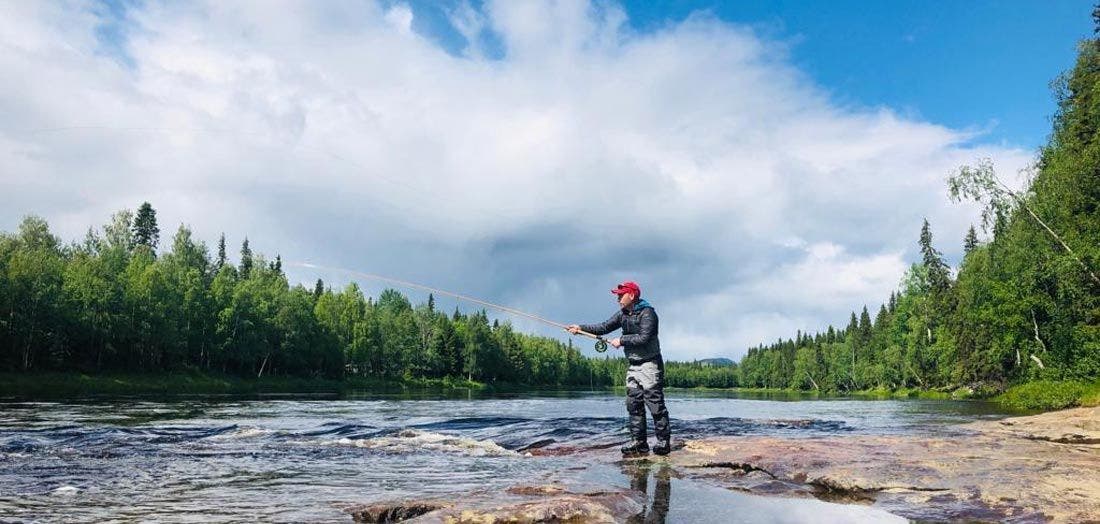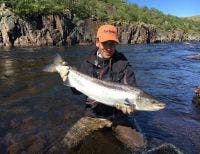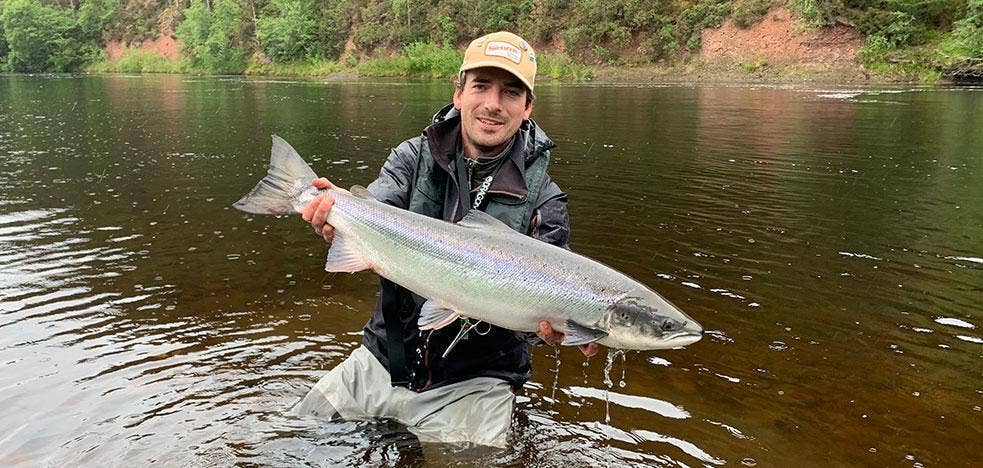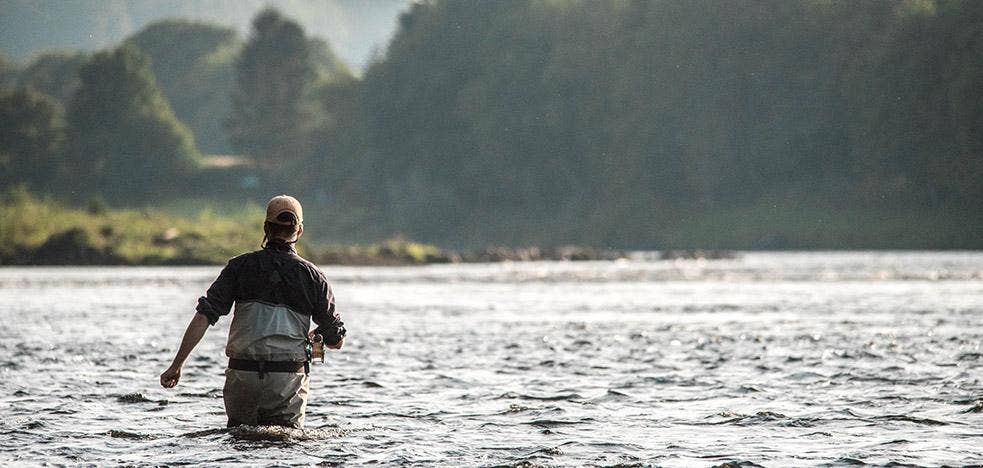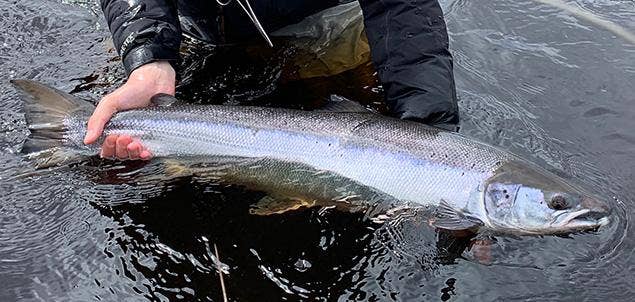We’ve seen fabulous runs of fish on the Spey, the Tweed has been producing good catch figures, Eden anglers have enjoyed some wonderful sport, and the Tay system has been steadily picking away (with not many rods on the river).
Rivers in Iceland and Ireland are also reporting strong runs of fish this year. We’ll have to wait and see if these fish head further south so English and Welsh rivers can get in on the action too, but so far so good.
Jonny's Top Tips for Summer Salmon Fishing
Know Where to Look
Grilse will hold in the same key lies and pools as their larger multi-sea winter brothers and sisters, but it really pays to flick a fly into more unusual spots too. As the prime lies in pools become occupied by larger spring and early summer fish, grilse can often be found in those ‘secondary’ locations that you might skip over earlier in the season.Necks and tails
As water temperatures start to increase, make sure to start high up in your chosen pool where water flow and oxygenation are highest. If there’s white water at the top of the pool, start there – you’d be surprised at some of the places in which grilse will happily sit.Fish the necks of pools carefully and don’t ignore shallow areas just off the main current. Don’t go splashing into a pool immediately but instead approach with stealth, stand back, keep your profile low, start high, and fish your fly right into the shallows before you start to fish down the main pool. Particularly if you’re fishing early in the morning before the sun is high in the sky, these shallow areas just off the current in the necks of pools can help get your day off to a great start.
This goes for the tails of pools too - you will often find grilse lying right on the cusp of the pool, especially if there is a V-shaped current slipping away towards a section of rough water. Fish your fly right into start of the rough water and you will often pick up a grilse right on the edge.
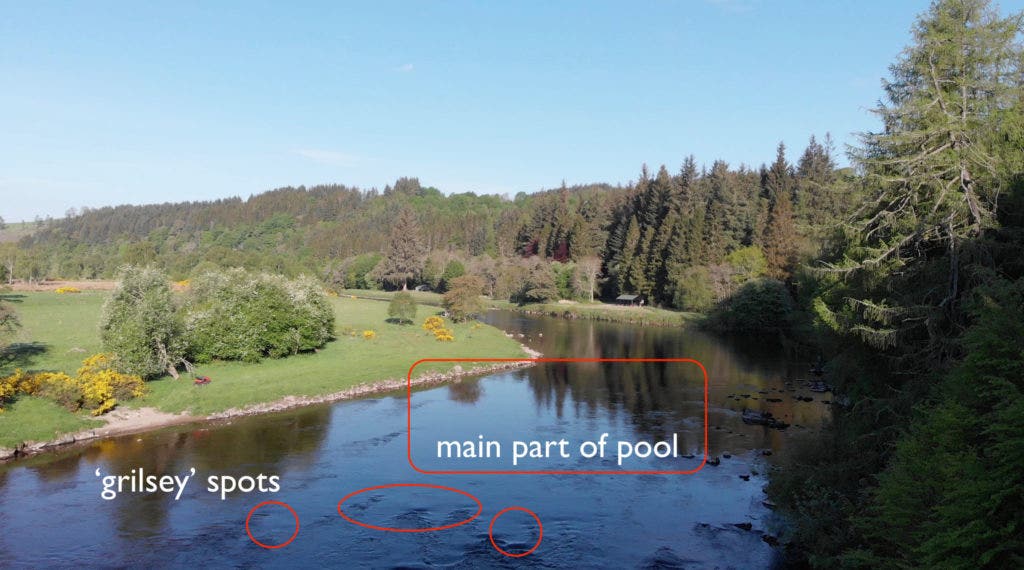 Grilse spots in the tail of a pool
Grilse spots in the tail of a poolPots
‘Pots’, or small deep holes often found in runs between main pools, are also great spots to search for grilse. Perhaps not secure enough to hold bigger fish, these locations often make a perfectly comfortable lie for a 3-4lb grilse. If you’re fishing a beat and have been through the main holding pools, go searching for pots while you rest the main pools for later. Pots are good holding spots if the weather is hot and sunny too as they’re characterised by rougher, highly oxygenated water, and the various converging currents found there provide some concealment for fish.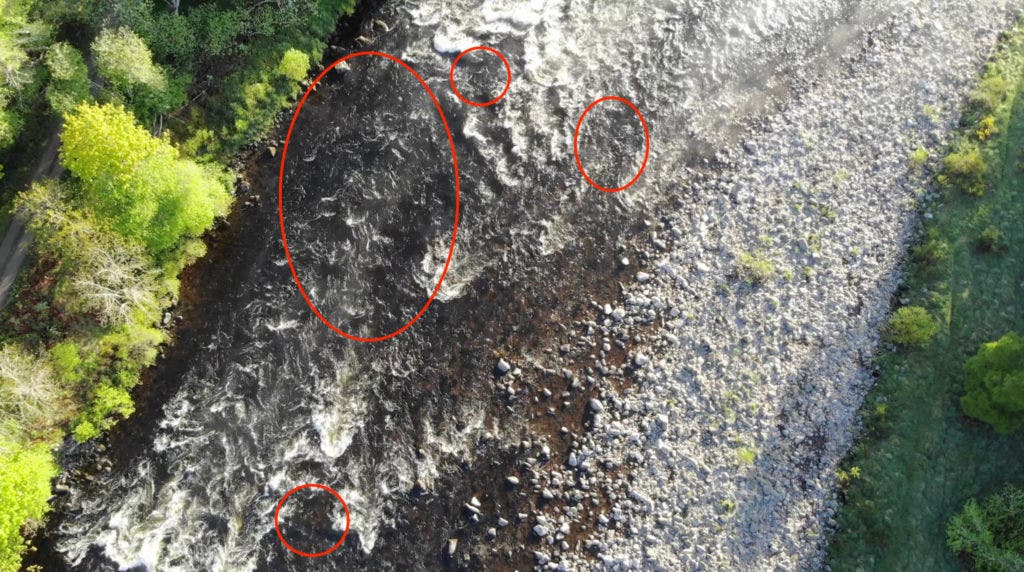 Examples of pocket water, or ‘pots‘
Examples of pocket water, or ‘pots‘Help, I keep losing grilse!
Grilse have a pesky habit of falling off the hook and anyone who has fished for them in the past has probably lost as many, if not more, than they have landed. Unfortunately, this comes with the territory. The ‘tug is the drug’, but there are a few things to be aware of in how grilse can take the fly, and how they fight, that might help you put a few more in the net.There are no hard and fast rules, sometimes a grilse will really slam the fly, but more often than not, at least in my experience, a grilse encounter is characterised like this:
- Gentle Take, fish hooked in front of mouth
- Fish flaps about on the surface before swimming upstream, mad reeling ensues
- Head-banging, furious jumping, and general chaos…
Check your Hooks
Grilse can be finicky takers. Sometimes they’ll really wallop a fly but at other times the take will be almost as gentle as a trout sipping down a nymph. I’ve found that, more often than not, a grilse will take a fly right in the front of its mouth. Considering the smaller size of grilse, and therefore less weight behind the fish to set the hook, as well as their softer mouths, using strong, sharp hooks is a must.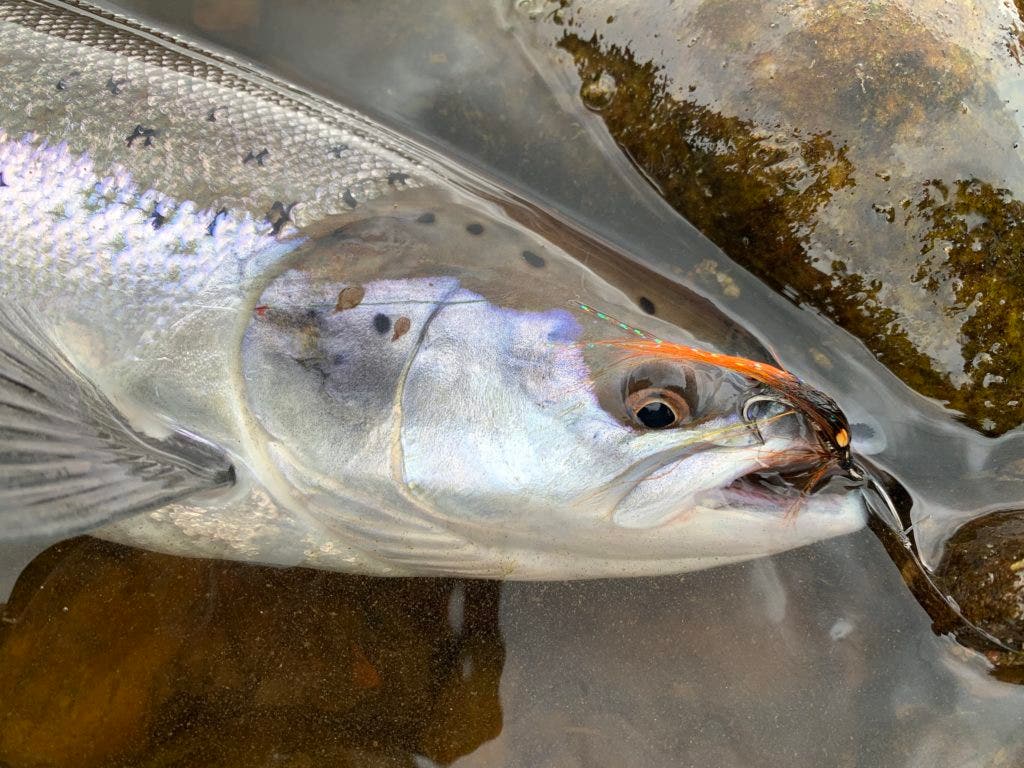 A sea-liced grilse, hooked perfectly in the front of the mouth.
A sea-liced grilse, hooked perfectly in the front of the mouth.If you’re fishing a dressed fly, make sure your hooks aren’t blunt. If they are, sharpen them or throw them away. If you’re swinging a tube, consider a small treble hook for a good hook-hold or a nice sharp size 10/12 double. There is some debate around the damage done by treble hooks to fish that are to be returned, and I think this is certainly true with larger hooks (size 8 and up), but in my experience small trebles (size 10/12 and down) can hook grilse securely in the front of the mouth without doing too much lasting harm. Do make sure that you adhere to the rules of your particular river or beat though.
Consider a lighter, softer rod
This one is a risk, especially if you’re likely to run into a much bigger fish on your particular river. If however you’re right in the thick of a grilse run, or your river happens to be predominantly a grilse system, switching to a softer-actioned rod with a lower line rating might just help you keep more grilse on the hook. If you fish in the spring with a 14ft 9wt, consider dropping down to a 12-12ft 6’’ 7wt or a 13ft 8wt for example. The lighter fly rod should let you bend into smaller grilse a bit more confidently without so many pinging off!Take a look at our recommended salmon fishing tackle.
Bow to the head-bangers
Who’s heard the phrase ‘keep your rod high’ when playing a salmon? Probably all of us! I question this as a hard-and-fast rule, especially when playing a grilse that is thrashing about on the surface and head-banging more furiously than a metalhead at a Slayer concert…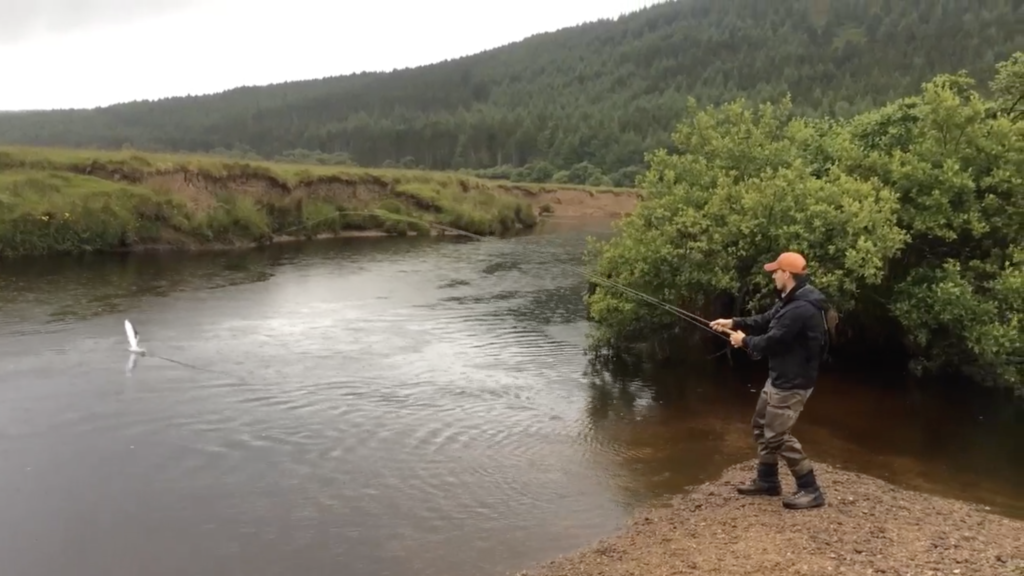 Moment of terror – a jumper!
Moment of terror – a jumper!The key is to keep a bend in the rod and allow it to work as a shock absorber - this doesn’t necessarily mean you have to create this bend vertically, it works just as well on a horizontal plane. If you’ve hooked a fish that is fighting in this way, apply side-pressure to discourage it from coming up to the surface of the water. As soon as your fish is airborne, your chances of losing it increase dramatically! By applying pressure laterally, rather than vertically, you can try to keep the fight sub-surface.
Where there’s one, there’s more!
Usually when summer salmon fishing I like to rest a pool for a few minutes after catching a fish, particularly if a big fish has run downstream through areas I was planning to fish through next. This thinking goes straight out the window when grilse fishing though.Grilse will often travel upstream in little groups or ‘pods’ and you’ll often hook more than one fish in exactly the same spot. Once you’ve landed a fish, don’t delay - get right back into the river, go back upstream a few yards and fish through the same spot again, you might just tempt another member of the gang.
Time and Tide
If you’re fishing on a section of river not too far from the sea, do pay attention to tide times as well. I’ve always operated on the belief that fish travel upstream at approximately 2-3mph, and I’ve found that to be roughly (roughly!) accurate. If, for example, you’re fishing 10 miles from the sea and high tide is at 3pm, don’t pack up at 5! You might just find that 7pm - 8pm is the magic hour on that particular day. ‘Gentleman’s Hours’ of 9-5 might work fine some days, but take the weather and tides into account and plan your fishing hours accordingly.A final note - handle with care…
Do remember that this time of year can see water temperatures rising - one of the key factors that can influence post-release mortality. This is the most important time of year to ‘keep ‘em wet’ so keep your handling of fish that are to be released to an absolute minimum and keep air exposure to a few seconds or none at all. For some useful fish handling tips, check out our Salmon Handling and Photography Guide »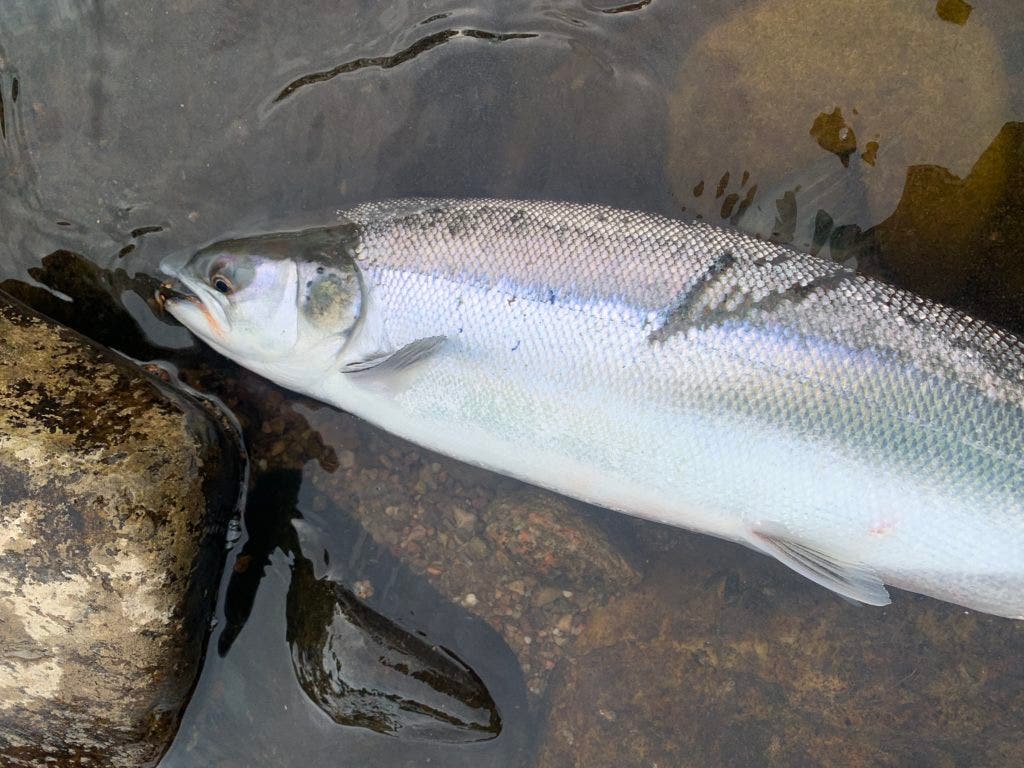 A quick ‘keep em wet‘ snap
A quick ‘keep em wet‘ snapBOOK SALMON FISHING WITH FISHPAL
Itching to get back on the river? Our friends at FishPal can make it happen! With access to some of the best beats available, you can also find out information about water levels and the latest catch reports.


